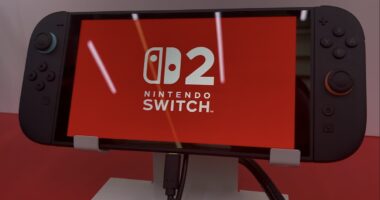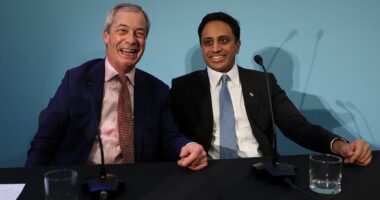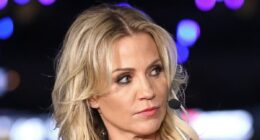President Donald Trump on Sunday insisted there will be no exemptions in the tariffs after there was some confusion when it came to electronics.
‘Nobody will be let off the hook for the unfair trade imbalances and non-monetary tariff barriers that other countries have used against us, especially China, which treats us the worst!’ the president posted on Truth Social.
A notification released late on Friday indicated that electronics would be exempt from a 125 percent import tax on Chinese goods established by Trump, as well as from his broad 10 percent global tariffs.
But his administration clarified on Sunday that electronics would be subject to other tariffs.
‘There was no Tariff “exception” announced on Friday,’ Trump continued in his post.
‘These products are subject to the existing 20% Fentanyl Tariffs, and they are just moving to a different Tariff “bucket,”’ he continued.
The president stated: ‘We are currently examining semiconductors and the entire electronics supply chain in the upcoming National Security Tariff Investigations.’

Donald Trump (pictured at UFC 314 on Saturday) insist no one is getting ‘off the hook’ when it came to his tariffs

Trump (with UFC president and CEO Dana White) took to Truth Social to blast suggestion that electronics would be exempt
Trump, 78, fresh from a visit to his golf club on Sunday blasted China in his post, claiming the U.S. would not be ‘held hostage by other Countries, especially hostile trading Nations like China.’
He argued Beijing, which is in an escalating trade war with the U.S., will ‘do everything within its power to disrespect the American People.’
Last week, China hiked its levies on goods imported from the U.S. to 125 percent after Trump effectively raised tariffs on Chinese goods to 145 percent.
The post on Sunday came after Trump appeared to spare electronics like iPhones and laptops momentarily from his sweeping tariffs, but the prospect of an exemption was short lived.
Commerce Secretary Howard Lutnick clarified on Sunday those products will be part of the tariffs that are still to come.
The top Trump administration official appeared on ABC News’ ‘This Week’ where he was asked by host Jon Karl about the electronic exemption revealed in a notice late Friday.
‘Well remember those products are going to be part of the semiconductor sectoral tariffs which are coming,’ Lutnick said.
He said like the separate pharmaceutical and auto tariffs, electronics will face levies as part of the semiconductor tariffs.
‘They’re going to have a special focused type of tariff to make sure that those products get reshored,’ Lutnick explained.
He argued such products need to be made in America, so the electronics are exempt from the ‘reciprocal’ tariffs but will be included in tariffs coming ‘in a month or two.’
Lutnick did not get into specific details about the looming tariffs, but said they will have a ‘tariff model in order to encourage them to reshore to be built in America.’
‘This is not like, a permanent sort of exemption,’ he said.

President Trump’s post on Sunday about there being no exemptions to his tariffs and taking aim at China as the trade war escalates

Commerce Secretary Howard Lutnick said electronics would be included in the sectional tariffs that are coming on semiconductors in the next month or two
In a notice revealed late on Friday, the unexpected tariff exclusion allowed gadgets will avoid Trump’s 125 percent import tax on Chinese goods – and even his sweeping 10 percent global tariffs.
The list of exempt items includes smartphones, laptop computers, hard drives, memory chips and processors – all tech essentials that are rarely made in the United States.
Experts say it would take years to ramp up domestic production, if it happens at all.
More than 80 percent of all Apple products are made in China — including a staggering 80 percent of iPads and over half of all Mac computers, according to data from Evercore ISI.
In the days following Trump’s tariff announcement, Apple saw $640 billion wiped from its market value.
But it was not clear at the time if the tariff timeout would be permanent as the White House move appeared to stem from technical rules that stop overlapping tariffs – meaning the products could have still faced new levies in the near future.
Lutnick’s comments on Sunday clarified that the exemptions would be temporary.

Trump (speaking to reporters on Air Force One on Saturday) took another shot at China who he claimed ‘treats us the worst!’
Trump’s current industry-focused tariffs sit at 25 percent, but it’s unclear what rate semiconductors, chipmaking tools and other electronics could ultimately face.
Analysts warn that relocating iPhone production to the U.S. would be a monumental task, both logistically and financially.
Bank of America Securities analyst Wamsi Mohan previously estimated that producing the iPhone 16 Pro Max domestically could increase its price by 91 percent, pushing it from $1,199 to approximately $2,300.
Wedbush Securities analyst Dan Ives also suggested the cost could soar even higher, potentially reaching $3,500 per unit.

Apple iPhone 16 models are displayed at a store in London amid fears the price could soar

Apple boss Tim Cook ensured his company got an exemption for billions of dollars in imports of Chinese-made smartwatches and other components during President Donald Trump’s first term in the White House
The challenges stem from higher labor costs in the U.S. — around $200 per unit compared to $40 in China — and the lack of a skilled workforce for specialized manufacturing tasks.
Apple CEO Tim Cook has previously highlighted the scarcity of qualified tooling engineers in the U.S., noting that while China boasts a vast pool of such talent, the U.S. has a significant shortfall.
In response to the escalating tariffs, Apple has taken swift action to mitigate potential disruptions.
The company chartered flights to expedite the shipment of approximately 1.5 million iPhones from India to the U.S., aiming to preempt the impact of the tariffs.
This move underscores Apple’s reliance on its global supply chain and the challenges of rapidly adjusting production logistics.

















